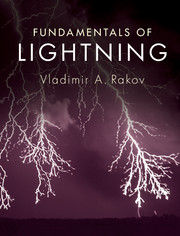Book contents
- Frontmatter
- Dedication
- Contents
- Preface
- 1 Types of lightning discharges and lightning terminology
- 2 Incidence of lightning to areas and structures
- 3 Electrical structure of thunderclouds
- 4 Properties of the downward negative lightning discharge to ground
- 5 Calculation of lightning electromagnetic fields
- 6 Modeling of the lightning return stroke
- 7 Measurement of lightning electric and magnetic fields
- 8 Electromagnetic methods of lightning location
- 9 Lightning damaging effects and protective techniques
- Appendices
- References
- Index
2 - Incidence of lightning to areas and structures
Published online by Cambridge University Press: 05 April 2016
- Frontmatter
- Dedication
- Contents
- Preface
- 1 Types of lightning discharges and lightning terminology
- 2 Incidence of lightning to areas and structures
- 3 Electrical structure of thunderclouds
- 4 Properties of the downward negative lightning discharge to ground
- 5 Calculation of lightning electromagnetic fields
- 6 Modeling of the lightning return stroke
- 7 Measurement of lightning electric and magnetic fields
- 8 Electromagnetic methods of lightning location
- 9 Lightning damaging effects and protective techniques
- Appendices
- References
- Index
Summary
Introduction
The number of flashes per unit area per unit time is called the “flash density,” and the number of ground flashes per unit area per unit time (usually per square kilometer per year) is called the “ground flash density.” A global flash rate of 100 s−1 corresponds to a flash density over the entire Earth's surface of about 6 km−2 yr−1 and a ground (land or sea) flash density of about 1.5 km−2 yr−1 if we assume a three-to-one global ratio of cloud to cloud-to-ground flashes. Lightning activity is highly variable on both (1) a temporal scale at a given location, ranging from some tens of years to the lifetime of individual thunderstorm cells, which is of the order of one hour (Chapter 3), or shorter, and (2) a spatial scale ranging from continents and oceans to a few kilometers or less. The ground flash density Ng is the basic information needed for the estimation of the lightning strike incidence to a ground-based object or system. Other measures of the lightning incidence to an area include the annual number of thunderstorm days TD and the annual number of thunderstorm hours TH. The latter two measures are usually converted into Ng using empirical formulas and are generally considered to be the last resort, when no suitable measurements of Ng for the area in question are available.
Thunderstorm days
The annual number of thunderstorm days TD, also called the “keraunic level,” is the only parameter related to the lightning incidence for which worldwide data are available extending over many decades. In fact, in some specific locations such data are available for more than a century. A thunderstorm day is defined as a local calendar day during which thunder is heard at least once at a given location. The practical range of audibility of thunder is about 15 km, with the maximum range of audibility being typically about 25 km. Thunderstorm-day data are recorded at most weather stations, generally by human observers, and the spatial distribution of long-term average values of TD is often presented in the form of isokeraunic maps. Examples of such maps are shown in Figs. 2.1 and 2.2, for the entire world and for the contiguous United States, respectively.
- Type
- Chapter
- Information
- Fundamentals of Lightning , pp. 17 - 30Publisher: Cambridge University PressPrint publication year: 2016



